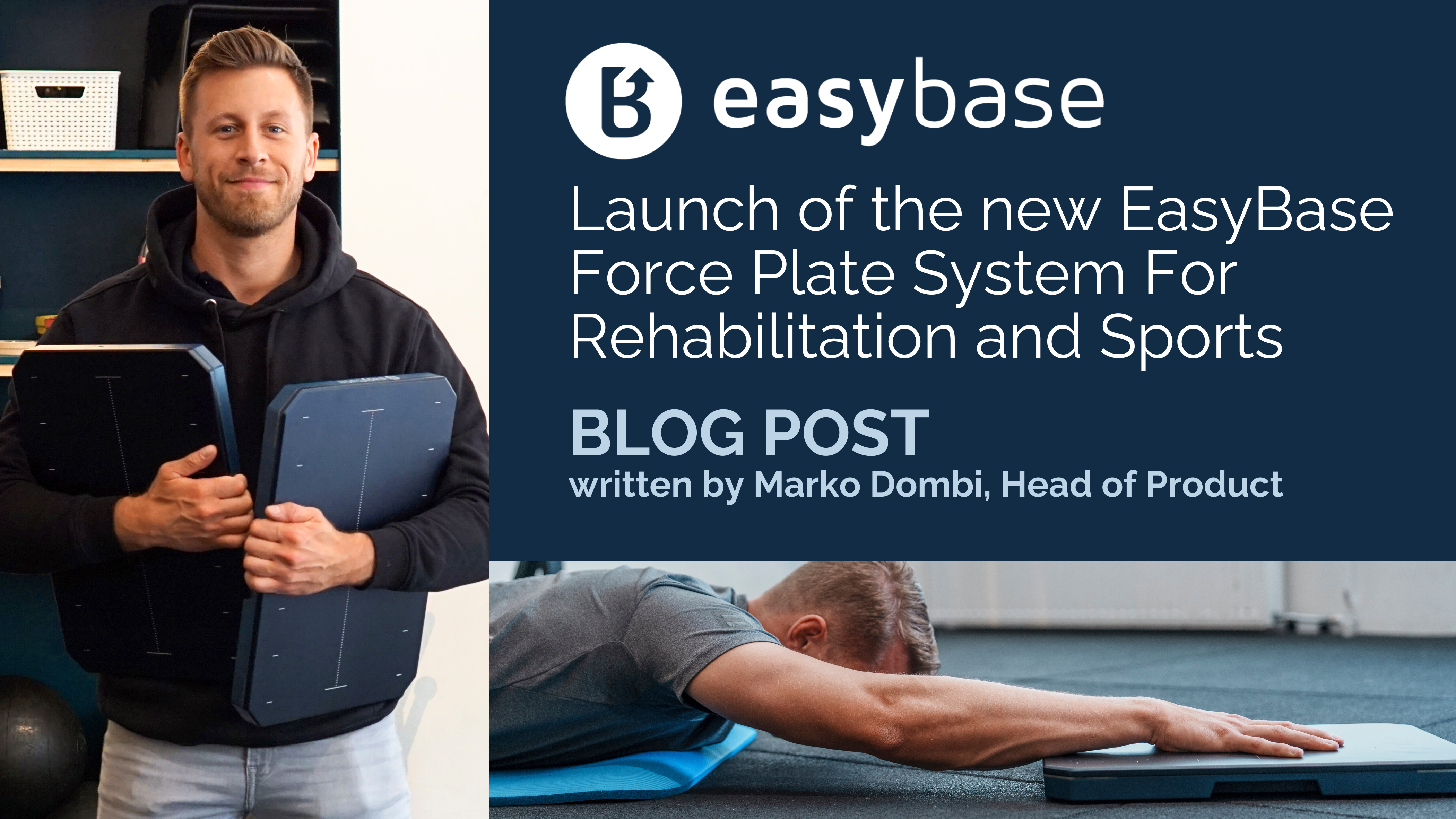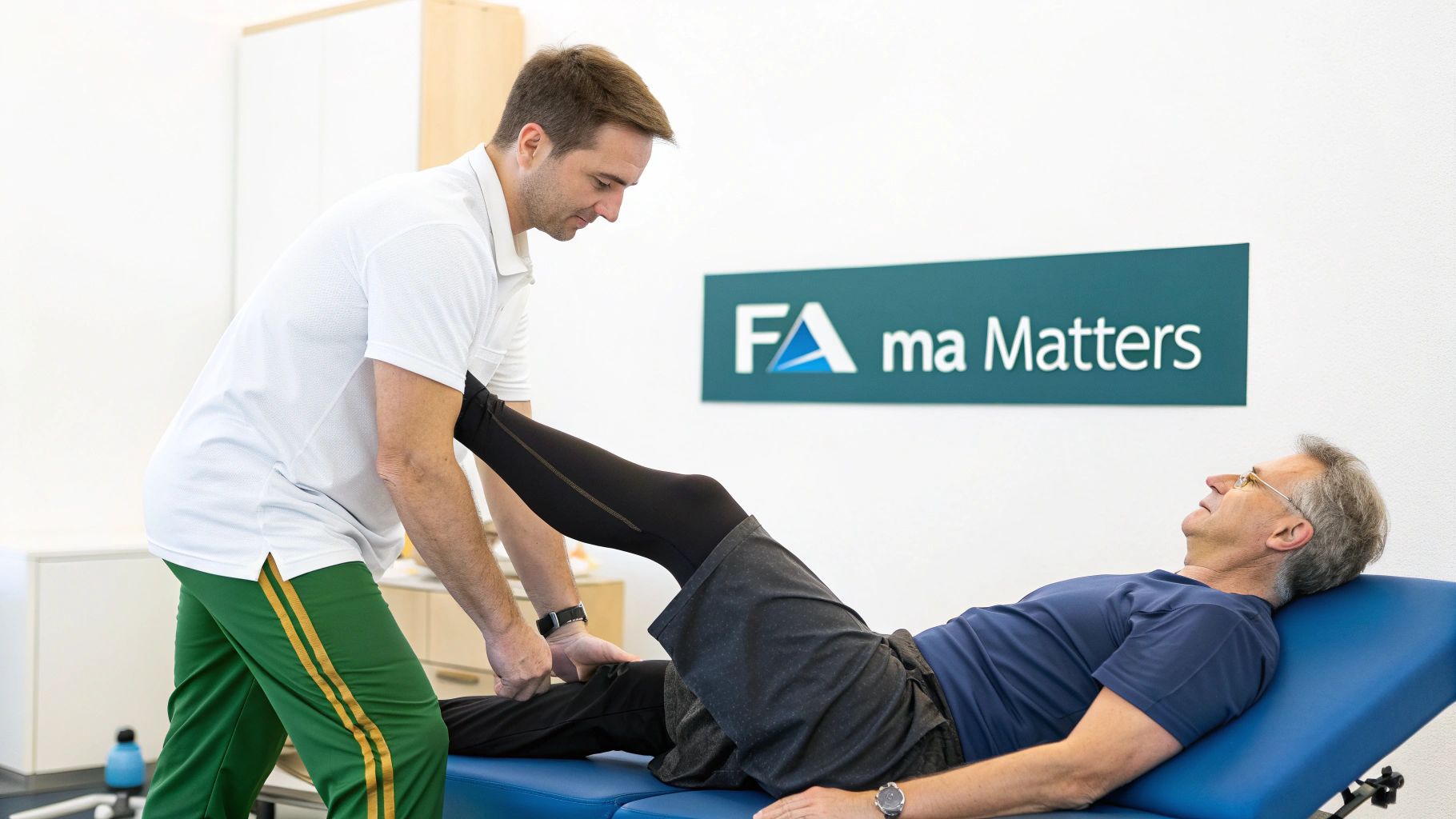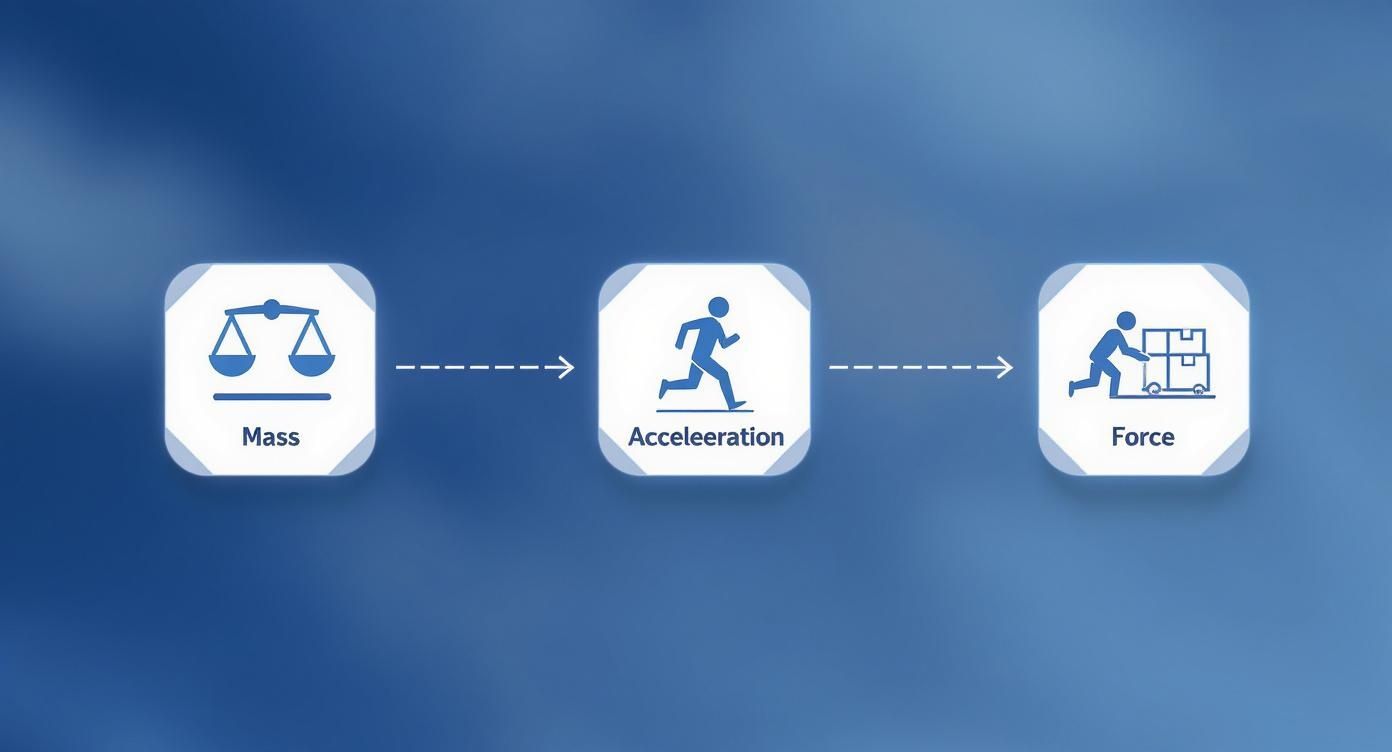-

, by Marko Dombi Athlete-Centric Care: Elevating ACL Rehab with Next-Gen Performance Tools
-

, by Marko Dombi Launch of the EasyBase - Force Plate System For Rehabilitation and Sports
-

, by Marko Dombi Interview with the researcher | Enhanced Paper Grip Test Project
Unlocking the Force Calculations Formula in Rehab and Performance
- , by Team Meloq
- 18 min reading time

Master the force calculations formula (F=ma) in rehab and sports. This guide breaks down complex physics into practical steps for physiotherapists.
Physics formulas can seem intimidating. But what if one simple equation could fundamentally change how you approach rehabilitation and athletic performance?
The core force calculations formula is F = ma, where Force equals Mass multiplied by Acceleration. This isn't just an abstract concept from a textbook; it governs every single client interaction, from a gentle leg lift to an explosive jump. Understanding this principle is foundational for creating effective and safe conditioning programs.
Why the Force Calculations Formula Matters in Rehab

At its heart, the principle states you need a greater push (Force) to move more 'stuff' (Mass) at a faster rate (Acceleration).
Think about pushing an empty sled versus a heavily loaded one. The empty sled (low mass) requires minimal force to get moving. The loaded sled (high mass), however, demands a significant amount of force to achieve the same acceleration. This same logic applies directly to every exercise you prescribe in a clinical or performance setting.
From Ancient Ideas to Modern Science
Understanding this relationship wasn't always so clear-cut. For centuries, scientific ideas about force were largely qualitative.
It wasn't until the late 17th century that Sir Isaac Newton revolutionised physics with his Second Law of Motion. His work finally quantified the direct connection between force, mass, and acceleration, transforming our ability to predict and measure movement.
This monumental shift from abstract thought to a precise force calculations formula is what allows modern practitioners to move beyond guesswork. It provides a solid framework for understanding the real mechanical demands placed on the human body, forming a crucial part of the rehabilitation frame of reference needed for effective patient care.
A foundational understanding of F=ma allows practitioners to view every exercise through the lens of biomechanics. It explains why controlling a movement slowly feels different from performing it explosively and why adding mass increases the challenge.
Breaking Down the Core Force Formula (F = ma)
To make this crystal clear, let's break down each piece of the formula. This table decodes each variable and connects it to the world of clinical and sports science.
| Component (Variable) | What It Really Means | Standard Unit (SI) | Clinical Analogy |
|---|---|---|---|
| Force (F) | The push or pull exerted on an object. | Newtons (N) | The effort an individual's muscles produce to lift a dumbbell, push against a resistance band, or jump off the ground. |
| Mass (m) | The amount of "stuff" or matter in an object. | Kilograms (kg) | The mass of the client's limb, their total body mass, or the external resistance they are moving (like a kettlebell). |
| Acceleration (a) | The rate of change in velocity—how quickly it speeds up. | Meters/second² (m/s²) | The speed of a box jump, the control in a slow eccentric squat, or the explosiveness of a medicine ball throw. |
Seeing it laid out this way, the formula becomes less of an abstract rule and more of a practical tool for analysing human movement.
The Practical Application in Physiotherapy and Conditioning
This isn't just about crunching numbers; it's about delivering better outcomes. A solid grasp of force principles helps you:
- Design Safer Programs: By understanding the forces acting on joints and tissues, you can modify exercises to prevent overload and protect healing structures.
- Improve Client Communication: Explaining why an exercise feels challenging in simple terms of force, mass, and speed can improve patient buy-in and adherence.
- Quantify Progress: Force is a measurable variable. Tracking an individual's ability to produce force provides objective data to validate interventions and demonstrate tangible results.
Ultimately, mastering this concept provides the foundational knowledge needed for safer, more effective, and evidence-informed client programming.
Speaking the Same Language: Physics in the Clinic
To apply these force calculations effectively, practitioners need to use a common language. Just as clinicians agree on anatomical terms, we need a shared understanding of force, mass, and acceleration. This ensures that data on a client's output is clear, repeatable, and universally understood.
The universal unit for force in science and rehabilitation is the Newton (N) (1). One Newton is defined as the force required to accelerate a 1 kilogram (kg) mass at a rate of 1 meter per second squared (m/s²).
Adhering to these standard international (SI) units is crucial for accurate and professional results. Mixing units—for instance, using pounds for mass and meters for distance—can lead to calculation errors and flawed clinical judgment. Consistency ensures your force calculations are reliable.
Putting It All Together in Practice
Let's apply this in a clinical setting. Imagine a client performing a dumbbell press with a 10 kg dumbbell. The mass (m) is 10 kg. To calculate the force of gravity acting on it (its weight), we multiply that mass by the acceleration due to gravity, which is approximately 9.8 m/s².
- Force (Weight) = 10 kg × 9.8 m/s² = 98 N
This calculation shows the client must produce over 98 Newtons of force just to hold the dumbbell steady. To lift it, they must generate even more force to create upward acceleration. This is a fundamental concept, especially when using tools that measure force directly. Understanding precisely how a dynamometer works helps connect the forces your clients produce with the data you collect.
By consistently using Newtons, kilograms, and meters per second squared, you turn every force measurement into a clear, actionable piece of data. This consistency is the bedrock of evidence-based practice, allowing you to accurately track progress and compare clients' data against established normative values (2).
Seeing Different Forces at Play in Human Movement
While F=ma is a tidy starting point, real-world human movement is far more complex. Our bodies are in a constant, dynamic interplay with numerous forces. To build effective rehabilitation and conditioning programs, we must understand this entire biomechanical picture.
The most relentless force we encounter is gravity. It's the silent partner in every bodyweight squat, lunge, and pull-up. The force calculations formula for an object's weight is simple: Weight (W) = mass (m) × gravitational acceleration (g). This basic equation sets the baseline challenge your clients must overcome, even before adding external loads.
Unseen Forces Shaping Every Movement
Beyond gravity, several other forces are crucial to the analysis of movement. These interactions, though often invisible, dictate the stability, control, and efficiency of every action.
Let's break down the key forces you'll encounter in a clinical setting:
- Normal Force: This is the force exerted by a surface to support an object resting on it. When a client stands still, the floor exerts an upward force exactly equal to their weight, preventing them from falling through. It’s the literal foundation of stability.
- Frictional Force: This is the force that resists motion between two surfaces in contact. The resistance felt when pushing a sled is a classic example of friction at work. It can be a powerful therapeutic tool for building strength.
- Tensional Force: This is the force transmitted through a cable, resistance band, or even a muscle and tendon when pulled taut. It's what a client feels when they stretch a band, and it’s what a healing tendon must learn to withstand during progressive loading.
This conceptual map illustrates how mass and acceleration are the two ingredients that combine to produce force.

This visual is a great reminder that force isn't an isolated property—it's the direct result of an object's mass being acted upon by acceleration.
A Deeper Scientific Perspective
Our practical understanding of forces like gravity and friction is built on centuries of scientific discovery. The journey to our modern force calculations formula wasn't a single "eureka" moment but a gradual process. This path led scientists to identify the four fundamental forces of nature: gravitational, electromagnetic, strong nuclear, and weak nuclear. The evolution from Newton's classical mechanics to the realities of quantum physics is a remarkable story in science.
Recognizing these different forces allows you to move beyond a one-dimensional view of exercise. A simple step-up isn’t just about overcoming gravity; it’s about managing normal force for balance, friction for foot stability, and internal muscular tension for control.
By widening your diagnostic lens to see all these forces in play, you develop a much richer, more complete picture of the challenges your clients face, leading to smarter and more effective interventions.
How to Apply Force Calculations in Your Practice
We've covered the basics. Now, let's bridge the gap between textbook physics and daily practice in the clinic or on the field. It’s one thing to know a force calculation formula, but another to use it to make smarter clinical decisions.
Let's look at how these principles play out in the real world, from the explosive power of an athlete to the delicate control needed in post-operative rehabilitation.
From Linear Sprints to Rotational Joints
Picture an athlete exploding out of the starting blocks. Their goal is to generate maximal horizontal force to propel their body mass forward. This is F = ma in its purest form. More force equals more acceleration, which means a faster sprint. The formula quantifies how much power their body must produce to achieve elite speeds.
Now, consider a patient days after surgery, carefully lifting their leg. The mass of their leg is unchanged, but the goal is the opposite: slow, deliberate movement. The required force is minimal and precise. Calculating this helps set realistic strength goals and, importantly, ensures the patient isn't placing excessive stress on healing tissue. Two different scenarios—one of raw power, one of fine control—are both governed by the same law of physics.
Introducing Torque: The Force of Rotation
While linear force is important, most human movements—walking, throwing, lifting—occur around joints. This means we must discuss rotation and a critical concept: torque (τ). Think of torque as the rotational equivalent of force.
Torque is the force that causes an object to rotate around an axis, like your lower leg swinging during a seated knee extension. The formula is straightforward:
Torque (τ) = Force (F) × Lever Arm (r)
The lever arm (r) is the perpendicular distance from the axis of rotation (your joint) to the line of action of the force. This simple relationship has significant implications for exercise prescription and injury prevention.
A Practical Example: Knee Extension
Let's return to the seated knee extension. Your quadriceps muscle contracts, pulling on the tibia to straighten your leg. The knee joint is the pivot point.
- Force (F): The pull generated by your quadriceps.
- Lever Arm (r): The distance from your knee joint to the quadriceps tendon insertion on the tibia.
- Torque (τ): The rotational outcome that straightens your leg.
Now, add a 5 kg ankle weight. You've introduced an external force trying to bend the knee. The force from that weight is W = mg = 5 kg × 9.8 m/s² = 49 N. Crucially, that force acts at the ankle, which has a much longer lever arm from the knee than the quadriceps tendon insertion.
This is why a small ankle weight feels so challenging. The long lever arm multiplies the rotational force your quadriceps must overcome. This principle, rooted in gravitational constants first explored centuries ago, remains central to our calculations today. If you're interested in the history, you can discover more insights about the timeline of gravitational physics and its impact on modern science.
By understanding torque, you can modify exercises to increase or decrease difficulty, strategically loading or protecting a joint to create a safer, more effective path to recovery.
To bring this all together, let’s look at how these formulas are used in different clinical and athletic situations. It’s about picking the right tool to get the information you need.
Applying Force Formulas in Clinical and Athletic Scenarios
| Scenario | Formula to Use | What the Calculation Reveals |
|---|---|---|
| ACL Return-to-Play Testing | Torque (τ) = F × r | Calculates the rotational force the hamstrings can produce to protect the knee, helping determine readiness for return to sport. |
| Sprinting Analysis | Force (F) = ma | Quantifies the ground reaction force an athlete needs to generate to achieve a target acceleration. |
| Early Post-Op Shoulder Rehab | Work (W) = Fd | Measures the total energy expended during a controlled range of motion exercise, ensuring the patient isn't overworking healing tissues. |
| Rotator Cuff Strength Assessment | Torque (τ) = F × r | Objectively measures the shoulder's rotational strength deficits by applying force at a specific distance from the joint. |
| Countermovement Jump Analysis | Impulse (J) = FΔt | Reveals how effectively an athlete applies force over time during takeoff, a key indicator of explosive power. |
These examples show that whether you're working with an elite athlete or a patient taking their first post-surgical steps, the principles of force are always at play, guiding your decisions and helping you quantify progress.
Using Technology to Measure Force Objectively
While the force calculations formula provides a theoretical foundation, modern technology allows us to measure force with high precision. This turns subjective clinical assessments into data-driven insights, bridging the gap between abstract formulas and tangible patient outcomes.
Let’s look at the key tools that make force visible, quantifiable, and actionable. These instruments empower us to move beyond what we see with our eyes and understand what the body is actually doing.
Ground Truth from Force Plates
Force plates are advanced sensors that measure the forces exerted on the ground. When a person stands, walks, or jumps on them, the plates record ground reaction forces (GRF) in real-time. This is a direct application of Newton's Third Law: for every action, there is an equal and opposite reaction.
This data reveals crucial details about movement that the naked eye cannot see. For example, analysing a vertical jump shows not just jump height but also the rate of force development—how quickly an athlete can generate peak power (3). This is invaluable for assessing explosive strength and identifying subtle asymmetries between limbs that could indicate an increased injury risk. To see how this tech is applied, you can dive into the details of force plate testing in our comprehensive guide.
By quantifying ground reaction forces, clinicians can assess dynamic balance, landing mechanics, and gait patterns with objective data. In post-injury rehabilitation, a limb symmetry index showing a discrepancy of 10-15% or more in force production is often considered a significant threshold that may warrant further clinical attention before a full return to sport (4).
The Power of Dynamometry
While force plates measure our interaction with the ground, dynamometry focuses on isolated muscle strength. Handheld dynamometers are a cornerstone of modern physiotherapy, providing a clear numerical value for the force output of specific muscle groups. These tools replace the subjectivity of manual muscle testing with precise measurements in Newtons.
A typical assessment is straightforward: a therapist holds the device against a patient's limb and asks them to push or pull as hard as possible. The dynamometer records the peak force, providing a quantifiable strength baseline. This is essential for:
- Identifying Weakness: Objectively pinpointing specific muscular deficits that may be the root cause of pain or dysfunction.
- Tracking Progress: Showing a patient their strength gains in concrete numbers from one session to the next is a powerful motivator.
- Assessing Imbalances: Comparing the strength of opposing muscle groups or the same muscle on different sides of the body helps guide targeted interventions.
Together, these technologies translate the abstract force calculations formula into actionable clinical insights. They provide the objective evidence needed to build highly specific training programs, validate rehabilitation strategies, and confidently guide clients toward their goals.
References
- Winter EM, Maughan RJ. The Physiology of Training. In: Standring S, editor. Gray's Anatomy: The Anatomical Basis of Clinical Practice. 41st ed. Elsevier; 2016. p. 144-152.
- Hegedus EJ, Goode A, Cook C, Michener L, Myer C, Myer DM, et al. Which physical examination tests provide clinicians with the most value when examining the shoulder? Update of a systematic review with meta-analysis of individual tests. Br J Sports Med. 2012;46(14):964-78.
- McMahon JJ, Suchomel TJ, Lake JP, Comfort P. Understanding the key phases of the countermovement jump force-time curve. Strength Cond J. 2018;40(4):56-66.
- Grindem H, Snyder-Mackler L, Moksnes H, Engebretsen L, Risberg MA. Simple decision rules can reduce reinjury risk by 84% after ACL reconstruction: the Delaware-Oslo ACL cohort study. Br J Sports Med. 2016;50(13):804-8.
Your Guide to Common Questions About Force
As you delve into the force calculations formula, some practical questions often arise. Let's address the most common ones heard from clinicians, providing clear, actionable answers.
This section bridges the gap between textbook theory and practical application on the clinic floor.
What Is the Difference Between Mass and Weight?
This is arguably the most critical distinction in biomechanics. It often causes confusion but is straightforward once clarified.
Mass is the amount of "matter" an object contains—like a client's limb or a kettlebell. It is measured in kilograms (kg) and remains constant regardless of location, whether on Earth or the Moon.
Weight, however, is a force. It is the pull of gravity on that mass, and its scientific unit is the Newton (N). The formula is simple: Weight = Mass × Gravitational Acceleration (W = mg). A client’s mass is constant, but the force their muscles must overcome—their weight—is what truly dictates the challenge of an exercise.
How Does This Formula Apply to Bodyweight Exercises?
The force calculations formula is at play in every bodyweight movement. When your client performs a push-up, they must generate an upward force greater than the gravitational force on their body mass to accelerate themselves away from the floor.
That is F=ma. Similarly, during the downward phase, their muscles produce a braking force to control the descent, decelerating their mass against gravity's pull. This relationship is even more apparent in explosive movements like a vertical jump, where a massive amount of force is needed to create rapid upward acceleration.
Grasping this conceptual shift—that bodyweight exerts a force (in Newtons) and is not just a mass (in kilograms)—is a game-changer. It clarifies the real mechanical demands of an exercise and helps you reason through progressions and regressions with greater precision.
How Can I Use These Concepts Without Advanced Equipment?
You don't need a laboratory full of expensive equipment to think and coach like a biomechanist. The principles themselves are powerful.
- Coach for Acceleration: Understanding that acceleration is a key variable that multiplies force demand can instantly upgrade your coaching cues. Pushing for faster concentric movements in a strength exercise dramatically increases the force required. Explaining this concept to clients can improve their intent and effort.
- Use Simple Math: Use a whiteboard to calculate the static force of a dumbbell (W=mg) to show a client the true load their joints are handling. It makes the abstract tangible.
- Explain Leverage: Explaining how moving a weight further from a joint (increasing the lever arm) amplifies the torque can create a powerful "aha" moment for a patient, helping them understand why a small adjustment makes an exercise significantly harder.
This foundational, conceptual understanding is a cornerstone of evidence-based practice—and it's more powerful than any single piece of equipment.
Ready to stop guessing and start measuring? The Meloq ecosystem, featuring the EasyForce dynamometer and EasyAngle goniometer, gives you the tools to quantify what truly matters. See how our accurate, portable devices can help you measure patient progress and make decisions driven by real data at https://www.meloqdevices.com.



